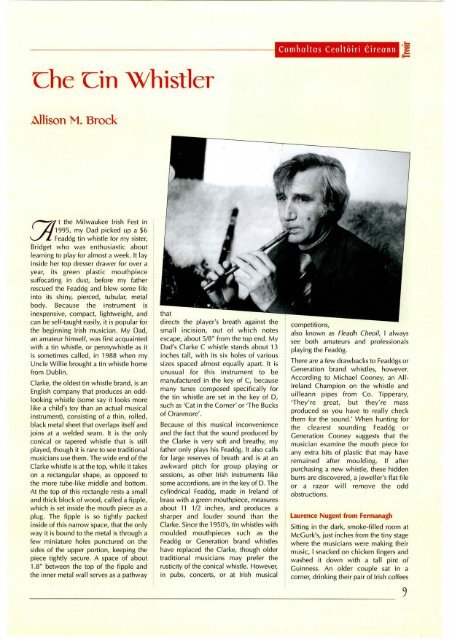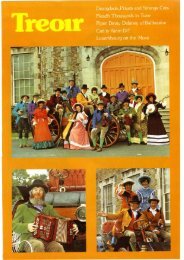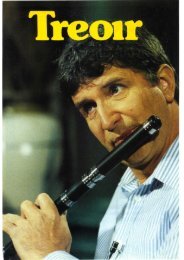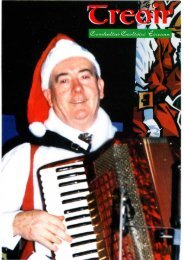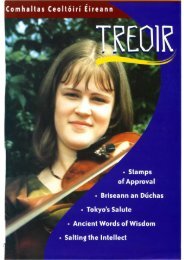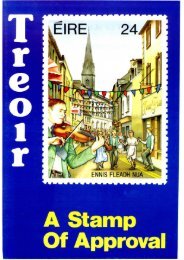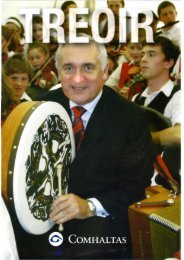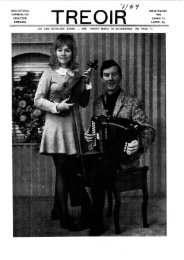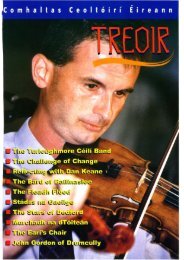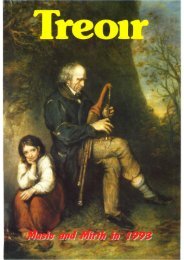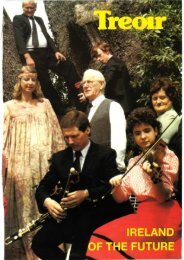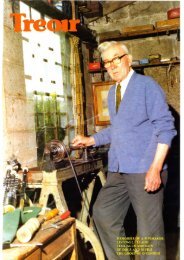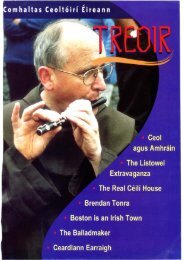Create successful ePaper yourself
Turn your PDF publications into a flip-book with our unique Google optimized e-Paper software.
Che Cin Whistler<br />
L\llison M. Brock<br />
- t the Milwaukee Irish Fest in<br />
1995, my Dad picked up a $6<br />
71; Fead6g tin whistle for my sister,<br />
Bridget who was enthusiastic about<br />
learning to play for almost a week. It lay<br />
inside her top dresser drawer for over a<br />
year, its green plastic mouthpiece<br />
suffocating in dust, before my father<br />
rescued the Fead6g and blew some life<br />
into its shiny, pierced, tubular, metal<br />
body. Because the instrument is<br />
inexpensive, compact, lightweight, and<br />
can be self-taught easi Iy, it is popu lar for<br />
the beginning Irish musician. My Dad,<br />
an amateur himself, was first acquainted<br />
with a tin whistle, or pennywhistle as it<br />
is sometimes called, in 1988 when my<br />
Uncle Willie brought a tin whistle home<br />
from Dublin.<br />
Clarke, the oldest tin whistle brand, is an<br />
English company that produces an oddlooking<br />
whistle (some say it looks more<br />
like a child's toy than an actual musical<br />
instrument), consisting of a thin, rolled,<br />
black metal sheet that overlaps itself and<br />
joins at a welded seam. It is the only<br />
conical or tapered whistle that is still<br />
played, though it is rare to see traditional<br />
musicians use them. The wide end of the<br />
Clarke whistle is at the top, while it takes<br />
on a rectangular shape, as opposed to<br />
the more tube-like middle and bottom.<br />
At the top of this rectangle rests a small<br />
and thick block of wood, called a fipple,<br />
which is set inside the mouth piece as a<br />
plug. The fipple is so tightly packed<br />
inside of this narrow space, that the only<br />
way it is bound to the metal is through a<br />
few miniature holes punctured on the<br />
sides of the upper portion, keeping the<br />
piece tightly secure. A space of about<br />
1.8" between the top of the fipple and<br />
the inner metal wall serves as a pathway<br />
directs the player's breath against<br />
small incision, out of which notes<br />
escape, about 5/8" from the top end. My<br />
Dad's Clarke C whistle stands about 13<br />
inches tall, with its six holes of various<br />
sizes spaced almost equally apart. It is<br />
unusual for this instrument to be<br />
manufactured in the key of C, because<br />
many tunes composed specifically for<br />
the tin whistle are set in the key of D,<br />
such as 'Cat in the Corner' or 'The Bucks<br />
of Oranmore' .<br />
Because of this musical inconvenience<br />
and the fact that the sound produced by<br />
the Clarke is very soft and breathy, my<br />
father only plays his Fead6g. It also calls<br />
for large reserves of breath and is at an<br />
awkward pitch for group playing or<br />
sessions, as other Irish instruments like<br />
some accordions, are in the key of D. The<br />
cylindrical Fead6g, made in Ireland of<br />
brass with a green mouthpiece, measures<br />
about 11 1/2 inches, and produces a<br />
sharper and louder sound than the<br />
Clarke. Since the 1950's, tin whistles with<br />
moulded mouthpieces such as the<br />
Fead6g or Generation brand whistles<br />
have replaced the Clarke, though older<br />
traditional musicians may prefer the<br />
rusticity of the conical whistle. However,<br />
in pubs, concerts, or at Irish musical<br />
competitions,<br />
also known as Fleadh Cheoil, I always<br />
see both amateurs and professionals<br />
playing the Fead6g.<br />
There are a few drawbacks to Fead6gs or<br />
Generation brand whistles, however.<br />
According to Michael Cooney, an AII<br />
Ireland Champion on the whistle and<br />
uilleann pipes from Co. Tipperary,<br />
'They're great, but they' re mass<br />
produced so you have to really check<br />
them for the sound .' When hunting for<br />
the clearest sounding Fead6g or<br />
Generation Cooney suggests that the<br />
musician examine the mouth piece for<br />
any extra bits of plastic that may have<br />
remained after moulding. If after<br />
purchasing a new whistle, these hidden<br />
burrs are discovered, a jeweller's flat file<br />
or a razor wi II remove the odd<br />
obstructions.<br />
Laurence Nugent from Fermanagh<br />
Sitting in the dark, smoke-filled room at<br />
McGurk's, just inches from the tiny stage<br />
where the musicians were making their<br />
music, I snacked on chicken fingers and<br />
washed it down with a tall pint of<br />
Guinness. An older couple sat in a<br />
corner, drinking their pair of Irish coffees<br />
9


